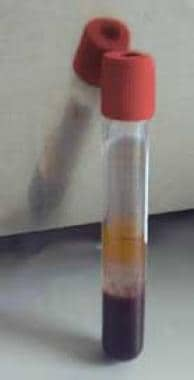
The reference ranges for aspartate aminotransferase (AST) are as follows.
Adults: 0-35 units/L or 0-0.58 μKat/L (SI units) (Values tend to be slightly lower in females than males.) [1]
Elderly: Values are slightly higher than those of other adults. [1]
0-5 days: 35-140 units/L < 3 years: 15-60 units/L 3-6 years: 15-50 units/L 6-12 years: 10-50 units/L 12-18 years: 10-40 units/LConditions associated with very high aspartate aminotransferase levels (more than 10 times the highest normal value) are as follows:
Liver damage (acute viral hepatitis, toxins/drugs including acetaminophen overdose, acute fulminant hepatitis)
Tumor necrosisConditions associated with moderately high aspartate aminotransferase levels are as follows:
Chronic liver disease Alcohol abuse Cholestasis Heart damage (heart attack, heart failure) Kidney damage Muscle injury (muscular dystrophy, dermatomyositis, trauma) Heatstroke (level dependent on extent of tissue damage) High consumption of vitamin A Pulmonary embolismConditions associated with slightly high levels of aspartate aminotransferase are as follows:
Fatty change in the liver Alcohol abuse Mononucleosis Drugs (ie, statins, aspirin, barbiturates, HIV medication, herbs)Collection and panel details are as follows:
Specimen: Blood serum Collection: Red top tube (see image below)
--> Red vacutainer tube.
Panels: Liver function panelAST is an enzyme found primarily in the liver and heart, but it is also found in many other tissues including the muscle, red blood cells, pancreas, kidney, and brain. Damage to these organs or hemolysis releases the enzyme, resulting in elevated AST levels in the serum. Serum levels generally parallel the extent of damage. [2]
Another enzyme, alanine aminotransferase or ALT, is primarily found in the liver. AST and ALT are often measured together as part of a liver function panel to detect liver damage. Liver diseases in which AST is higher than ALT include alcohol-induced liver damage, cirrhosis, and liver tumors. AST formerly was called serum glutamic oxaloacetic transaminase (SGOT). Aspartate transaminase catalyzes the interconversion of aspartate and α-ketoglutarate to glutamate.
Aspartate (Asp) + α-ketoglutarate ⇌ oxaloacetate + glutamate (Glu)
This test is indicated when liver disease is suspected (ie, jaundice, fatigue, loss of appetite, abdominal pain, nausea, vomiting, dark urine, pale colored stools, itching, ascites, mental changes, history of alcohol abuse, suspected acetaminophen overdose, family history of liver disease, exposure to hepatitis viruses).
This test is used to monitor liver function (ie, use of potentially hepatotoxic drugs, treatment of or status of chronic liver disease, hepatitis, alcohol-induced liver disease, cirrhosis, fatty liver disease, hepatic failure, Wilson’s disease, hemochromatosis). [3]
Keep in mind the following:
The AST:ALT ratio (De Ritis ratio) can be used to determine alcohol-induced liver disease with AST:ALT ratio of greater than 2. [4]
Elevated AST and normal ALT can indicate a normal liver, but damage to other organs and/or hemolysis. In acute hepatitis, AST levels usually stay high for about 1–2 months but can take as long as 3–6 months to return to normal. In chronic hepatitis, AST levels are usually not as high, often less than 4 times the highest normal level. Such smaller increases may also be seen when the bile ducts are blocked, or with certain cancers of the liver. [5] AST is may also increased after heart attacks/muscle injury, usually more than ALT.
Both AST and ALT are dependent on vitamin B6 (pyridoxal phosphate). Assays for AST and ALT assume adequate levels of vitamin B6 to accurately measure AST and ALT levels. Vitamin B6 depletion can result in artificially low AST and ALT levels.